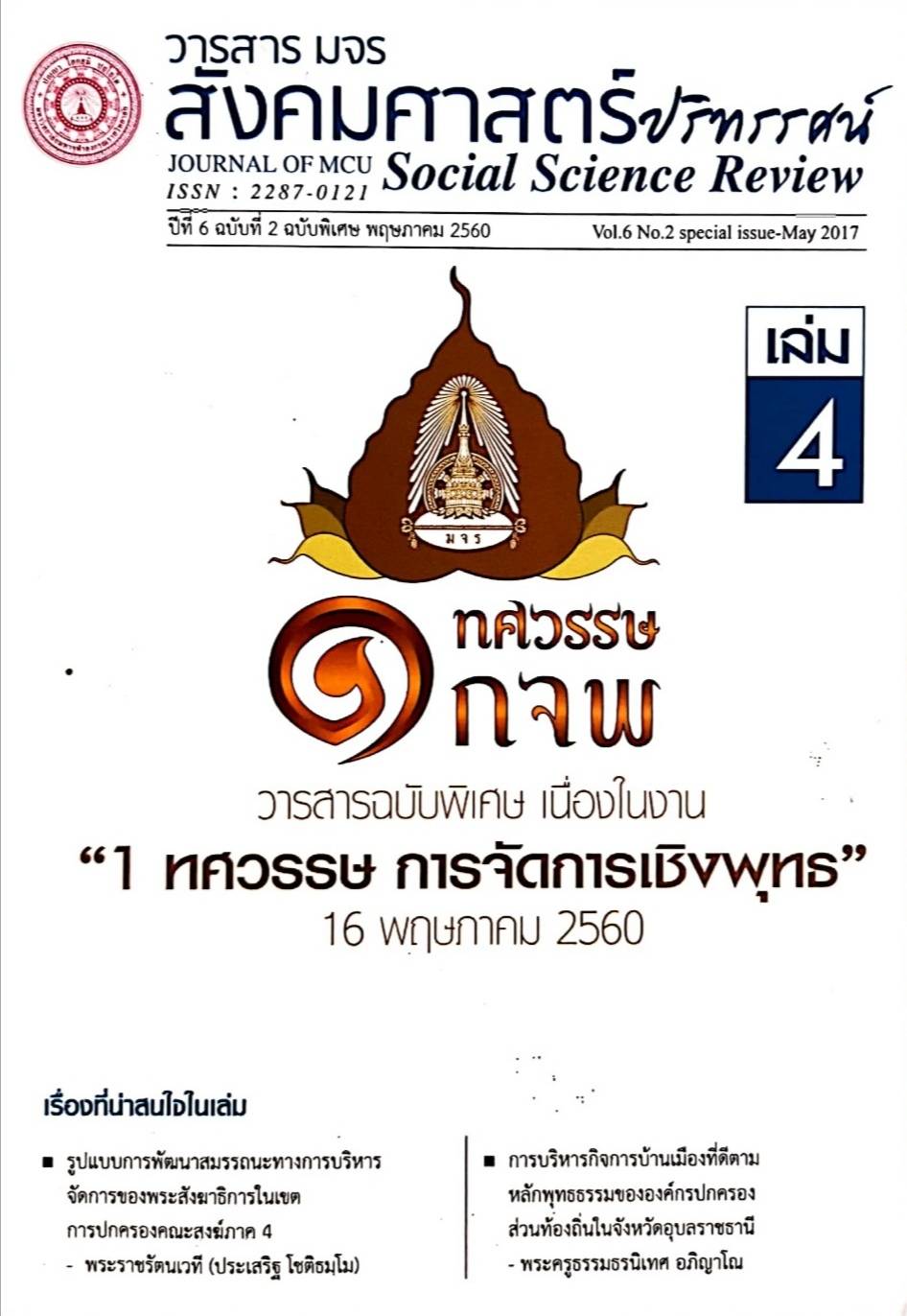พุทธวิธีการพัฒนาภาวะผู้นำของพระสังฆาธิการ เพื่อการบริหารจัดการวัดในจังหวัดชลบุรี
คำสำคัญ:
พุทธวิธี,การพัฒนาภาวะผู้นำ,การบริหารจัดการวัดบทคัดย่อ
การศึกษาวิจัยฉบับนี้มีวัตถุประสงค์เพื่อ 1. ศึกษาสภาพการบริหารจัดการวัดและภาวะ
ผู้นาของพระสังฆาธิการในจังหวัดชลบุรี 2. ศึกษาหลักพุทธธรรมและวิธีการพัฒนาภาวะผู้นาที่พึง
ประสงค์ในการบริหารจัดการวัดในจังหวัดชลบุรี 3. นาเสนอพุทธวิธีในการพัฒนาภาวะผู้นาของพระ
สังฆาธิการเพื่อการบริหารจัดการวัดในจังหวัดชลบุรี
ระเบียบวิธีวิจัยใช้ระเบียบวิธีวิจัยเชิงคุณภาพ โดยการศึกษาวิเคราะห์เอกสาร การ
สัมภาษณ์เชิงลึก กับผู้ให้ข้อมูลสาคัญซึ่งเป็นพระสังฆาธิการและเจ้าหน้าที่ที่เกี่ยวข้อง จานวน 30 รูป
หรือคน เครื่องมือที่ใช้ในการวิจัย ได้แก่ แบบสัมภาษณ์ เก็บรวบรวมข้อมูลโดยการจดบันทึกและการ
บันทึกเสียง วิเคราะห์ข้อมูลโดยการวิเคราะห์เนื้อหาเชิงพรรณนา และการสนทนากลุ่มเฉพาะ กับ
ผู้ทรงคุณวุฒิด้านการศาสนา และภาวะผู้นา จานวน 12 รูปหรือคน เครื่องมือที่ใช้ในการวิจัย ได้แก่
แบบสนทนากลุ่มเฉพาะและรูปแบบเบื้องต้นสาหรับใช้ในการยืนยันข้อมูล เก็บรวบรวมข้อมูลด้วยการ
จัดประชุมกลุ่มย่อย บันทึกเสียง และจดบันทึก วิเคราะห์ข้อมูลโดยการวิเคราะห์เนื้อหาเชิงพรรณนา
ผลการวิจัยพบว่า
1. สภาพการบริหารจัดการวัดและภาวะผู้นาของพระสังฆาธิการในจังหวัดชลบุรี พบว่า
(1) ด้านการปกครอง ขาดความรู้ความเข้าใจและการกระจายอานาจ ไม่นาหลักการพัฒนาแบบ
สมัยใหม่มาปรับใช้ ขาดการร่วมมือกันในการทางาน ขาดการวางระบบแบบแผนที่ดีในการปกครอง
(2) ด้านการศาสนศึกษา ขาดบุคลากร ทั้งภาคปริยัติธรรมแผนกนักธรรม และภาคพระปริยัติธรรม
แผนกบาลีมาก (3) ด้านการเผยแผ่พระพุทธศาสนา ขาดบุคลากรที่มีคุณภาพศักยภาพสูง ขาดการสนับสนุนงบประมาณอุดหนุน พัฒนาให้เจ้าอาวาสมีความก้าวหน้าในการเผยแผ่ และทักษะการใช้
ภาษา (4) ด้านการศึกษาสงเคราะห์ บุคลากรรองรับและงบประมาณในการจัดการศึกษาสงเคราะห์
ไม่พอเพียงกับการบริหารจัดการงาน ขาดการสนับสนุนและเครื่องมืออุปกรณ์ที่ทันสมัย (5) ด้าน
การสาธารณูปการ การจัดระเบียบแบบแผน เอกลักษณ์ของวัด และเอกลักษณ์แห่งพระพุทธศาสนา
ตามวิถีไทยอย่างรอบครอบ ขาดองค์ความรู้ในการบริหารจัดการ (6) ด้านการสาธารณสงเคราะห์
ขาดบุคลากร ขาดองค์ความรู้ด้านการจัดการ และขาดความร่วมมือทางเครือข่ายไม่เป็นระบบที่
ชัดเจนเป็นรูปธรรม สาหรับภาวะผู้นาของพระสังฆาธิการพบว่า พระสังฆาธิการในจังหวัดชลบุรีมี
ภาวะผู้นาสูง
2. หลักพุทธธรรมและวิธีการพัฒนาภาวะผู้นาที่พึงประสงค์ในการบริหารจัดการวัดใน
จังหวัดชลบุรี พบว่า ต้องอาศัยหลักพุทธธรรมทุติยปาปณิกสูตร 3 คือ (1) จักขุมา : การบริหารตน:
เก่งคิด เป็นผู้มีวิสัยทัศน์ที่กว้างไกล หรือทักษะด้านความคิด คิดกว้าง มองการไกล ใฝุสูง (2) วิธุโร :
การบริหารงาน: เก่งงาน คือ เป็นผู้ชานาญในงาน หรือทักษะด้านการปฏิบัติงาน รู้จักวิธีการบริหาร
จัดการ และ (3) นิสสยสัมปันโน : การบริหารคน : เก่งคน คือ เป็นผู้ที่มีมนุษยสัมพันธ์ดี หรือทักษะ
ด้านการสื่อสาร และได้รับความเชื่อถือจากผู้อื่น มีการร่วมมือประสานงานกัน และการพัฒนาภาวะ
ผู้นาวิถีพุทธตามหลักไตรสิกขา คือ การพัฒนาด้านศีล หรือการพัฒนาพฤติกรรมให้เหมาะสมกับสมณ
สารูป การพัฒนาด้านสมาธิหรือการพัฒนาจิตใจให้เข้มแข็งพร้อมปฏิบัติงาน และการพัฒนาด้าน
ปัญญาหรือการพัฒนาด้านความรู้ ให้มีคุณธรรมและความดี ด้วยวิธีการพัฒนาตามหลักของการ
อบรม ศึกษา และพัฒนา
3. พุทธวิธีการพัฒนาภาวะผู้นาของพระสังฆาธิการเพื่อการบริหารจัดการวัดในจังหวัด
ชลบุรี พบว่า (1) ด้านการปกครอง ผู้นาจะต้องมีคุณธรรมนามาใช้ในการปกครองและควรมีระบบ
แบบแผนในการปกครอง มีการกระจายอานาจ การส่งเสริมสนับสนุน มีการศึกษาอบรมทั้งทฤษฎี
และปฏิบัติ ในการบริหารกิจการคณะสงฆ์ทั้ง 6 ด้าน กาหนดบทบาทของคณะสงฆ์ให้ชัดเจน
มอบหมายงานที่สอดคล้องกับพระธรรมวินัย และกิจการคณะสงฆ์ตามกฎหมาย (2) การด้านการศา
สนศึกษา เจ้าอาวาสจะวางแผนการศึกษา ให้มีการศึกษา การอบรมสอบบาลี ตั้งทุนให้กับ
นักเรียนที่ยากจนแต่เรียนดี มุ่งเน้นให้ชุมชนเป็นศูนย์กลางทางการศึกษา ให้มหาเถรสมาคมออก
กฎระเบียบในการบังคับให้ผู้นาสงฆ์ปฏิบัติตามหลักการศึกษา เหมาะสมกับการปฏิบัติงาน (3) ด้าน
การเผยแผ่ มีแผนการฝึกอบรมพระนักเผยแผ่ จัดให้มีการรับฟังนโยบาย หลักการเผยแผ่ และฝึก
พูด เทศน์ บรรยายและผลิตสื่อการเผยแผ่พระพุทธศาสนา นาเทคโนโลยีสมัยใหม่มา เป็นศูนย์รวม
ในการเผยแผ่และมีความต่อเนื่องกัน ตั้งกองทุนสนับสนุน การสร้างเครือข่ายชาวพุทธทั่วโลก (4)
ด้านการสาธารณูปการ วางแผนแบบแปลนในการก่อสร้างถาวรวัตถุขึ้นในวัด จัดการก่อสร้างให้มี
ระเบียบ เน้นความสะอาด ควรอนุรักษ์ศิลปะของท้องถิ่น รูปแบบการก่อสร้างตามภูมิภาคตาม
ความเหมาะสม ตั้งธนาคารพระพุทธศาสนา (5) ด้านการศึกษาสงเคราะห์ แนวทางแห่ง
พระพุทธศาสนาเป็นการจัดการศึกษาแก่ประชาชนทั่วไปเพื่อช่วยเหลือเกื้อกูลแก่เด็กและ เยาวชนของชาติ ทั้งด้านการศึกษา เป็นผู้นาในการส่งเสริมและพัฒนาบุคลากรสงฆ์ให้มีความสามารถการ
อบรมสั่งสอนให้แก่บุคคลเหล่านั้นได้มีความรู้อย่างเหมาะสม ประสานงานให้ฝุายแต่ละฝุายใน
องค์กรดาเนินแนวทางตามกรอบทิศทาง (6) ด้านการสาธารณะสงเคราะห์ ช่วยเหลือสังคมทาง
วัตถุและจิตใจในรูปแบบต่างๆ ที่ไม่ขัดต่อพระธรรมวินัย ได้แก่การเป็นผู้นาในการ บูรณะและพัฒนา
วัดให้เป็นศูนย์กลางแห่งการสงเคราะห์ เป็นผู้นาในการพัฒนาวัดให้เป็นศูนย์กลาง ศูนย์รวมแห่งความ
ศรัทธาของผู้แสวงบุญสงเคราะห์ภิกษุสงฆ์สามเณร การสร้างถนนเข้าหมู่บ้าน การสนับสนุน
ทุนการศึกษาแก่เด็กนักเรียน การช่วยเหลือผู้ปุวย ผู้ยากไร้การสร้างหอสมุดโรงเรียนเป็นต้น
เอกสารอ้างอิง
โรงพิมพ์ กรมศาสนา
กองแผนงาน กรมการศาสนา กระทรวงศึกษาธิการ. (2540). คู่มือพระสังฆาธิการว่าด้วย
พระราชบัญญัติ กฎ ระเบียบและคาสั่งของคณะสงฆ์. กรุงเทพมหานคร : โรงพิมพ์การ
ศาสนา.
กองพุทธศาสนสถาน สานักงานพระพุทธศาสนาแห่งชาติ. (2548). วัดพัฒนา48. กรุงเทพมหานคร :
โรงพิมพ์สานักงานพระพุทธศาสนาแห่งชาติ.
พระเทพปริยัติสุธี วรวิทย์ คงฺคปญฺโญ. (2545). การคณะสงฆ์และการศาสนา. กรุงเทพมหานคร : โรง
พิมพ์ มหาจุฬาลงกรณราชวิทยาลัย.
พระธรรมปิฎก ป.อ. ปยุตฺโต. (2546).ภาวะผู้นา : ความสาคัญต่อการพัฒนาคน พัฒนาประเทศ.
กรุงเทพมหานคร : สานักพิมพ์ธรรมสภา.
พระพรหมคุณาภรณ์ ป.อ.ปยุตฺโต. (2540). ภาวะผู้นา. กรุงเทพมหานคร : สุขภาพใจ.
โชติ บดีรัฐ. (2540). “การบริหารงานของพระสังฆาธิการ ในเขตการปกครองคณะสงฆ์ภาค 4 เพื่อ
ความมั่นคง แห่งพระพุทธศาสนา”. วิทยานิพนธ์รัฐประศาสนศาสตรดุษฎีบัณฑิต. บัณฑิต
วิทยาลัย : มหาวิทยาลัยราชภัฏวไลย อลงกรณ์.
บัญชายุทธ นาคมุจลินท์. (2555). “วิเคราะห์การบริหารองค์กรในการเผยแผ่พระพุทธศาสนาของ
ศูนย์การเผยแผ่ พระพุทธศาสนาประจาจังหวัดอุทัยธานี”. วิทยานิพนธ์พุทธศาสตรดุษฎี
บัณฑิต พระพุทธศาสนา. บัณฑิตวิทยาลัย : มหาวิทยาลัยมหาจุฬาลงกรณราชวิทยาลัย.
ปรัชญา ชุ่มนาเสียว. (2550). “การพัฒนาภาวะผู้นาในองค์การด้วย E.Q.”. วิทยานิพนธ์ปรัชญา
ดุษฎีบัณฑิต .การพัฒนาทรัพยากรมนุษย์.บัณฑิตวิทยาลัย : จุฬาลงกรณ์มหาวิทยาลัย.
ดาวน์โหลด
เผยแพร่แล้ว
รูปแบบการอ้างอิง
ฉบับ
ประเภทบทความ
สัญญาอนุญาต
ลิขสิทธิ์ (c) 2020 วารสาร มจร สังคมศาสตร์ปริทรรศน์

อนุญาตภายใต้เงื่อนไข Creative Commons Attribution-NonCommercial-NoDerivatives 4.0 International License.
เพื่อให้เป็นไปตามกฎหมายลิขสิทธิ์ ผู้นิพนธ์ทุกท่านต้องลงลายมือชื่อในแบบฟอร์มใบมอบลิขสิทธิ์บทความให้แก่วารสารฯ พร้อมกับบทความต้นฉบับที่ได้แก้ไขครั้งสุดท้าย นอกจากนี้ ผู้นิพนธ์ทุกท่านต้องยืนยันว่าบทความต้นฉบับที่ส่งมาตีพิมพ์นั้น ได้ส่งมาตีพิมพ์เฉพาะในวารสาร มจร สังคมศาสตร์ปริทรรศน์ เพียงแห่งเดียวเท่านั้น หากมีการใช้ภาพหรือตารางหรือเนื้อหาอื่นๆ ของผู้นิพนธ์อื่นที่ปรากฏในสิ่งตีพิมพ์อื่นมาแล้ว ผู้นิพนธ์ต้องขออนุญาตเจ้าของลิขสิทธิ์ก่อน พร้อมทั้งแสดงหนังสือที่ได้รับการยินยอมต่อบรรณาธิการ ก่อนที่บทความจะได้รับการตีพิมพ์ หากไม่เป็นไปตามข้อกำหนดเบื้องต้น ทางวารสารจะถอดบทความของท่านออกโดยไม่มีข้อยกเว้นใดๆ ทั้งสิ้น





